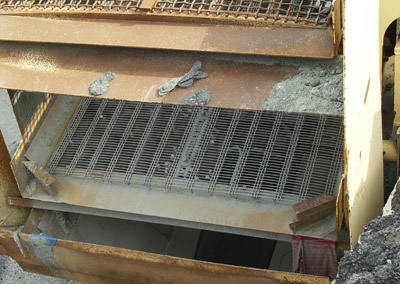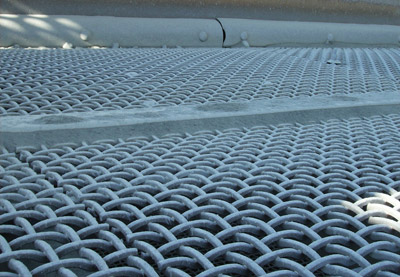Throughput & Screening Efficiency
 These two terms cannot be considered without regard to the screen media’s wear-life. Depending on the particular screening media in use, there is sometimes a fine line between efficiency and wear-life. The Vibrating Screen Manufacturers Association (VSMA) or the manufacturer of your vibrating screen can accurately determine the screening capacity needed on each deck for your aggregate separation requirements. These screening efficiency calculations involve aspects such as tons per hour, top size feed, open area of the screen media, and the inclination of the vibrating screen. Based on this information, the required square footage of screening surface can be determined. There are, however, several additional options to consider when examining the screening efficiency of your aggregate screen and screening situation.
These two terms cannot be considered without regard to the screen media’s wear-life. Depending on the particular screening media in use, there is sometimes a fine line between efficiency and wear-life. The Vibrating Screen Manufacturers Association (VSMA) or the manufacturer of your vibrating screen can accurately determine the screening capacity needed on each deck for your aggregate separation requirements. These screening efficiency calculations involve aspects such as tons per hour, top size feed, open area of the screen media, and the inclination of the vibrating screen. Based on this information, the required square footage of screening surface can be determined. There are, however, several additional options to consider when examining the screening efficiency of your aggregate screen and screening situation.
Gain More Open Area
The use of lighter wire diameters will naturally increase the open area, and in many screening situations this is beneficial. Wear-life, on the other hand, may suffer. This can be the “fine line,” previously mentioned, between efficiency and wear-life. Depending upon the aggregate sizing requirements, the use of Hoyt’s Oblong Openings and Long-Slot Opening Wire Screens can achieve both — more open area and longer wear-life.
Oblong Openings
This particular opening is a rectangular opening that provides a higher open area percentage versus traditional square openings. Oblong openings can be designed to prevent plugging conditions and also to maintain or increase wear-life. Oblongs should be considered for such applications as “de-sanding,” where the fines are simply removed from the courser aggregate. Additional screening or classifying can then be effectively performed on this fine material. Oblong openings are especially beneficial in wet sand and gravel screening operations where sand is separated from the gravel.
Long-Slot Openings
 Long-slot opening wire cloth is manufactured with a series of straight, uncrimped wires that are used to perform the aggregate separation. With long-slot openings a grouping of two or three fill wires firmly lock the straight wires together. Long-slot opening wire screens are ideally suited where “rough-sized” aggregate separation is desired. Great increases in open area and screening efficiency can be realized when employing long-slot openings. Aggregate material passing over and through this long-slot configuration is normally re-crushed and/or re-screened. Long-slot openings can be effectively used in crushed stone applications where blinding is prevalent. Specifically engineered long-slot openings also can be custom designed to match the location of the screen deck’s support bars. (see image)
Long-slot opening wire cloth is manufactured with a series of straight, uncrimped wires that are used to perform the aggregate separation. With long-slot openings a grouping of two or three fill wires firmly lock the straight wires together. Long-slot opening wire screens are ideally suited where “rough-sized” aggregate separation is desired. Great increases in open area and screening efficiency can be realized when employing long-slot openings. Aggregate material passing over and through this long-slot configuration is normally re-crushed and/or re-screened. Long-slot openings can be effectively used in crushed stone applications where blinding is prevalent. Specifically engineered long-slot openings also can be custom designed to match the location of the screen deck’s support bars. (see image)
Notice that the binding wires are positioned over the support bars; and, in this photo, they are in position over every other support bar on the bottom deck. Also, a “Row of Openings on Centerline” was specified to allow for use of the center hold-down bar. Because Hoyt Wire Cloth representatives are aware of the particular and important features of each vibrating screen, custom-designed screen cloth can be manufactured to ideally suit the screening application. This greatly improves screening efficiency and throughput. Care must be taken in this case when changing from a square opening to an oblong or long-slot aperture. We suggest that you contact your screen media supplier before attempting this change. If precisely sized aggregate is required, this may preclude the use of other opening shapes that are not square.
Direction of the Long Openings
This can be a VERY important consideration when deciding on the use of oblong or long-slot configuration wire screens. However, there is no right or wrong direction. Both are correct based on the particular screening application, production requirements, acceptable wear-life and the particular design of the screen deck. Hoyt Wire Cloth recommends that screen cloth tensioning occurs on the greatest number of wires possible. On traditional side-tensioned decks, this would position the slotted opening across the material flow. Please refer to the above photo where the long openings are transverse to the material flow. On end-tensioned screen decks, this positions the long openings parallel to the material flow, where the greatest number of tensioning wires exists. Tensioning on the greatest number of wires provides a far superior, stronger, and, in many applications, a longer-wearing screen that is not as susceptible to breakage.
The Hoyt Hi-Rise™ Screen
 Hoyt’s newly developed square opening Hi-Rise™ Screen offers substantially more open area while maintaining and, in many cases, increasing wear-life. This is accomplished by compressing a round diameter wire into an oblong shaped wire. This wire compression effectively reduces the wire diameter while expanding the height. The “shaped wire” is then positioned vertically and tightly woven, producing the Hoyt Hi-Rise™ Screen, which offers more open area and longer wear. Numerous applications of The Hi-Rise™ Screen are currently in use throughout the United States. Aggregate producers often realize dramatic improvements in screening efficiency and production by using Hi-Rise™ Screen Panels. (see image)
Hoyt’s newly developed square opening Hi-Rise™ Screen offers substantially more open area while maintaining and, in many cases, increasing wear-life. This is accomplished by compressing a round diameter wire into an oblong shaped wire. This wire compression effectively reduces the wire diameter while expanding the height. The “shaped wire” is then positioned vertically and tightly woven, producing the Hoyt Hi-Rise™ Screen, which offers more open area and longer wear. Numerous applications of The Hi-Rise™ Screen are currently in use throughout the United States. Aggregate producers often realize dramatic improvements in screening efficiency and production by using Hi-Rise™ Screen Panels. (see image)
Hoyt Hi-Rise Screen Panels
Hoyt Wire Cloth Company and affiliates will be happy to assist you in determining the correct screen for your particular screening application.

